by Elisa Zied | May 4, 2022 | books, fiction, middle grade novels, writer, writers, writing
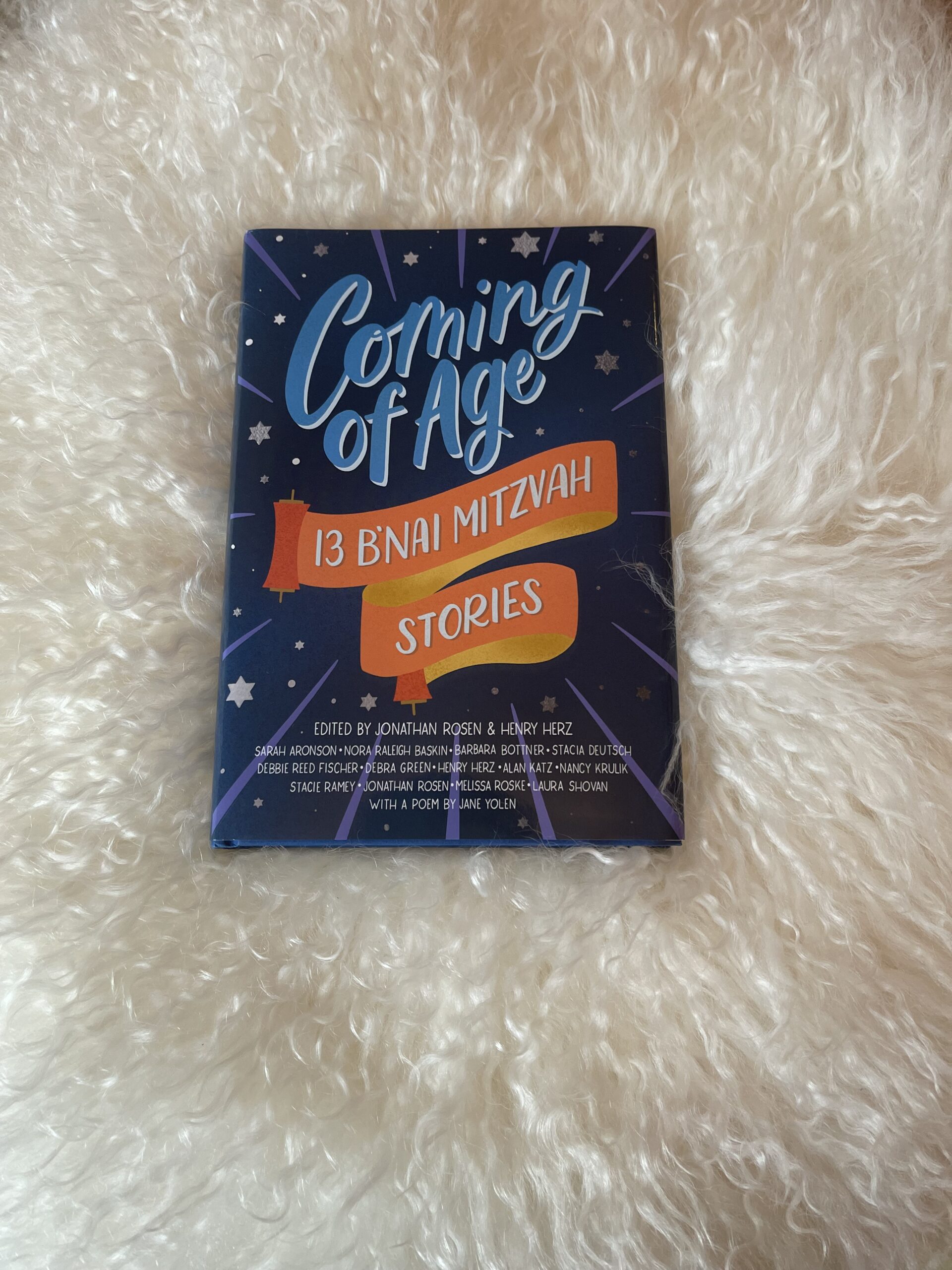 The moment I read about Coming of Age: 13 B’Nai Mitzvah Stories (Albert Whitman & Co., April 19, 2022), an anthology edited by Jonathan Rosen and Henry Herz, I knew it would be a must-read—and not just for its intended audience of 8 to 12-year-olds. Maybe the idea of the book made me nostalgic for my own bat mitzvah celebration that featured sparkly rainbow/unicorn centerpieces. Maybe it reminded me of the feeling of accomplishment after performing on the bimah after several months of practice alongside my friend Melissa. Maybe it was about remembering the party following my service, especially the rush of a slow dance with a cute boy to some early 80s ballad, or the fun of playing games like Coke and Pepsi and musical chairs with my school, camp, and family friends.
The moment I read about Coming of Age: 13 B’Nai Mitzvah Stories (Albert Whitman & Co., April 19, 2022), an anthology edited by Jonathan Rosen and Henry Herz, I knew it would be a must-read—and not just for its intended audience of 8 to 12-year-olds. Maybe the idea of the book made me nostalgic for my own bat mitzvah celebration that featured sparkly rainbow/unicorn centerpieces. Maybe it reminded me of the feeling of accomplishment after performing on the bimah after several months of practice alongside my friend Melissa. Maybe it was about remembering the party following my service, especially the rush of a slow dance with a cute boy to some early 80s ballad, or the fun of playing games like Coke and Pepsi and musical chairs with my school, camp, and family friends.
As I think about the trajectory of my own Judaism, I realize that all the rituals and practices from my childhood I had probably taken for granted took on so much more meaning as an adult as my husband and I tried to pass those on to our sons. And as we watched our boys read from the Torah and recite their d’var Torahs on the bimah in front of all four of their grandparents, and our family and friends, we could not be more proud.
Jewish or not, I hope you’ll check out this anthology, a great window into this rite of passage, and share it with your middle grade children and students.
I asked contributors of the anthology why they wanted to share their story, and what their bar or bat mitzvah taught them about Judaism or humanity. Here are some of their responses:
Melissa Roske, author of Kat Greene Comes Clean (Charlesbridge, 2017):

I’ve always felt that Jewish kids would benefit from an anthology like this one, so when Jonathan asked me to contribute a story to COMING OF AGE it was a no-brainer for me to to say YES!
In terms of what my bat mitzvah taught me about Judaism, well… that’s more complicated. I was extremely shy as a child, and speaking in public terrified me. Because of this, I focused on the actual reading of the Torah—of getting the words right, of not embarrassing myself in front of the congregation, or disappointing my parents—rather than on what the text actually meant. In many ways, I took Judaism for granted. Only later, after I’d had a chance to reflect on the experience, did I realize it was a privilege for me to become a bat mitzvah. To come of age as a Jew. It’s a shame I didn’t realize it at the time.
Nancy Krulik, author of more than 200 books for children and young adults, including three New York times bestsellers:
 I actually did not have a traditional bat mitzvah. My synagogue called it a “Bat Torah,” although we girls were not brought up to the bimah on Saturday to read from the actual Torah. Instead, we read a selection from the Book of Proverbs during the Friday night service. I was only the third girl in our congregation to have the ceremony. The “Bat Torah” was a compromise with our old-school rabbi, who did not feel women had any place on the bimah at all. It was a hard-fought battle, led by many girls in the Hebrew school, and our equally fierce parents. Today, young women in that same congregation have full-fledged b’not mitzvah, and the cantor is a woman. So, I guess what I learned is that change is hard, and it may take a lot of time, but it does come. Never give up fighting for equality in all aspects of life.
I actually did not have a traditional bat mitzvah. My synagogue called it a “Bat Torah,” although we girls were not brought up to the bimah on Saturday to read from the actual Torah. Instead, we read a selection from the Book of Proverbs during the Friday night service. I was only the third girl in our congregation to have the ceremony. The “Bat Torah” was a compromise with our old-school rabbi, who did not feel women had any place on the bimah at all. It was a hard-fought battle, led by many girls in the Hebrew school, and our equally fierce parents. Today, young women in that same congregation have full-fledged b’not mitzvah, and the cantor is a woman. So, I guess what I learned is that change is hard, and it may take a lot of time, but it does come. Never give up fighting for equality in all aspects of life.
I am a strong believer in the importance of people seeing themselves represented in books. For Jewish kids, particularly those who don’t live in predominantly Jewish communities, reading the stories in this collection can help validate who they are, and show them that there are plenty of other soon-to-be 13-year-olds with the same questions and struggles. I wanted to be a part of a project that would provide Jewish kids with a mirror to look into with pride. But I also hope non-Jewish readers will pick up the collection and learn more about our faith. I truly believe the more we all learn about one another, the better the world will be.
Laura Shovan, award winning poet and author of several books for children including A Place at the Table (Clarion Books, 2020), co-written with Saadia Faruqui:
 There was a lot of family drama around my bat mitzvah. I wanted to write a story that captured that anxious feeling, but put a funny spin on it. To write “A Funny Thing Happened on the Way to the Bimah,” I studied farce, including the Stephen Sondheim musical, “A Funny Thing Happened on the Way to the Forum.”
There was a lot of family drama around my bat mitzvah. I wanted to write a story that captured that anxious feeling, but put a funny spin on it. To write “A Funny Thing Happened on the Way to the Bimah,” I studied farce, including the Stephen Sondheim musical, “A Funny Thing Happened on the Way to the Forum.”
My bat mitzvah was one of those times when I saw how important sharing the traditions of Judaism was to my family, especially my grandmother, Joy.
Barbara Bottner, author of over 40 books for children and young adults:
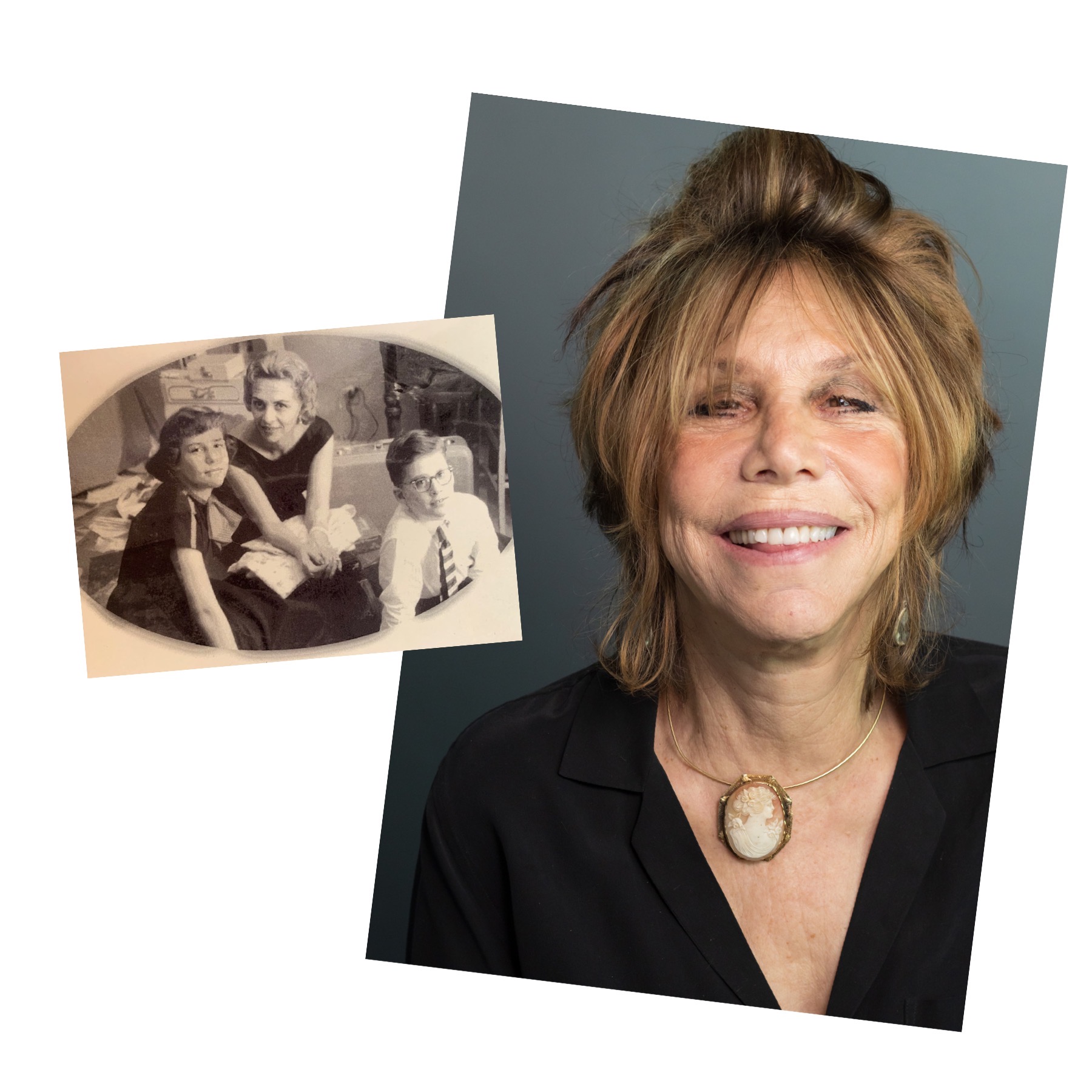 I’ve been wanting to do a Jewish-oriented story for a long time, so when I was invited to contribute to the anthology Coming of Age, it was an immediate yes. It was important for me to write something authentic, which is why I often write close to my own experiences. But my bat mitzvah was a by the book affair; there was nothing to draw on. So, I turned to history. I was fascinated to learn the first bat mitzvah in the country was in 1922 by Judith Kaplan, the daughter of a prominent New York City rabbi. That awakened my feminist leanings—why did it take so long, what kind of event was it? So, I investigated.
I’ve been wanting to do a Jewish-oriented story for a long time, so when I was invited to contribute to the anthology Coming of Age, it was an immediate yes. It was important for me to write something authentic, which is why I often write close to my own experiences. But my bat mitzvah was a by the book affair; there was nothing to draw on. So, I turned to history. I was fascinated to learn the first bat mitzvah in the country was in 1922 by Judith Kaplan, the daughter of a prominent New York City rabbi. That awakened my feminist leanings—why did it take so long, what kind of event was it? So, I investigated.
I learned that Kaplan’s bat mitzvah has already been covered. Bat mitzvahs took a while to take hold in the USA, so I wondered, what was the second such service like? Writing fiction, this was a delicious arena for a story. I set mine in the Lower East Side where I’d lived and also had acted in the Off-Broadway theater. I always felt kinship to the culture there, including the Jewish rialto, pulsing with the life of Yiddish humor, music and drama. I knew the blintzes from Ratner’s, and was familiar with the many family-owned businesses, and late-night spots. So, I invented almost thirteen-year-old Hannah, who’s the lone member of her outgoing, offbeat Yiddish theater family of actors. But Hannah is terrified to being onstage, due to extreme shyness. Not having been bathed in Sunday school, now she has questions about God’s treatment of females. She’s full of curiosity, loves her family, but has no rabbi to answer to; rabbi’s were busy with young men during this period. Luckily Hannah has her grandfather, a man of substance and a big heart, and he tutors her.
Wanting to deliver a relevant precedent for her Haftorah where females played an important part, I sleuthed through many to find one where two females, Jael and Deborah, act heroically to defeat Sisera and his armies. Then, I was ready to write. I tried to make it humorous. Jewish people are naturally good at humor and it connects to our resilience. Writing this was a great experience for me, so I hope it touches our readers.
Jonathan Rosen, co-editor of Coming of Age: 13 B’nai Mitzvah Stories and author of several middle grade books:

Well, since I helped put the anthology together, I figured contributing a short story was the right thing to do. But, seriously, I am very proud to be a part of Coming of Age. I thought it was important to have a place featuring Jewish stories, where Jewish kids could see themselves represented. I’m happy it’s out in the world.
I was fortunate enough to be living in Israel as a child, and had my bar mitzvah at the Western Wall. I remember even then of feeling the history and thinking about how many other Jewish kids had been at that spot for thousands of years. It just really resonated with me about the long line of history of the Jewish people, and the want to continue traditions and be a link in that chain.
Elisa Zied a writer for young people. She holds an MFA in Writing for Children and Young Adults from Vermont College of Fine Arts and an advanced Graduate Certificate in Children’s Literature from Stony Brook Southampton. She also earned a BA in psychology from University of Pennsylvania and an MS in clinical nutrition from New York University. Before embarking on a fiction writing career, she garnered millions of media impressions as a nutrition expert, spokesperson, and freelance health and nutrition writer. She also authored four award-winning nutrition titles including YOUNGER NEXT WEEK (Harlequin Nonfiction, 2014). She lives in New York City with her husband and two sons and is an avid walker, music lover, and amateur photographer.
by Elisa Zied | Mar 13, 2022 | books, fiction, MFA, middle grade novels, VCFA, writer, writers, writing, young adult books
Corey Ann Haydu has had quite a career. Besides being an amazing advisor in VCFA’s Writing for Children and Young Adults MFA program (I had the pleasure of working with and learning from her prior to doing the program as well as in my fourth semester), the acclaimed author has tackled everything from young adult and middle grade novels to chapter books to great effect with a combination of incredible skill in craft and her big, big heart. Her latest YA title, Lawless Spaces—her first novel in verse—is no exception. Here’s a brief description of the work that’s earned stars from Kirkus Reviews and Publisher’s Weekly, and is a Junior Library Guild Selection:
Perfect for fans of Deb Caletti, this poignant coming-of-age novel in verse follows a teen girl who connects with the women of her maternal line through their journals and comes to better understand her fraught relationship with her mother.
Mimi’s relationship with her mother has always been difficult. But lately, her mother has been acting more withdrawn than usual, leaving Mimi to navigate the tricky world of turning sixteen alone. What she doesn’t expect is her mother’s advice to start journaling—just like all the woman in her family before her. It’s a tradition, she says. Expected.
But Mimi takes to poetry and with it, a way to write down the realities of growing into a woman, the pains of online bullying, and the new experiences of having a boyfriend. And all in the shadows of a sexual assault case that is everywhere on the news—a case that seems to specifically rattle her mother.
Trying to understand her place in the world, Mimi dives into the uncovered journals of her grandmother, great-grandmother, and beyond. She immerses herself in each of their lives, learns of their painful stories and their beautiful sprits. And as Mimi grows closer to each of these women, she starts to forge her own path. But it isn’t until her mother’s story comes to light that Mimi learns about the unyielding bonds of family and the relentless spirit of womanhood.
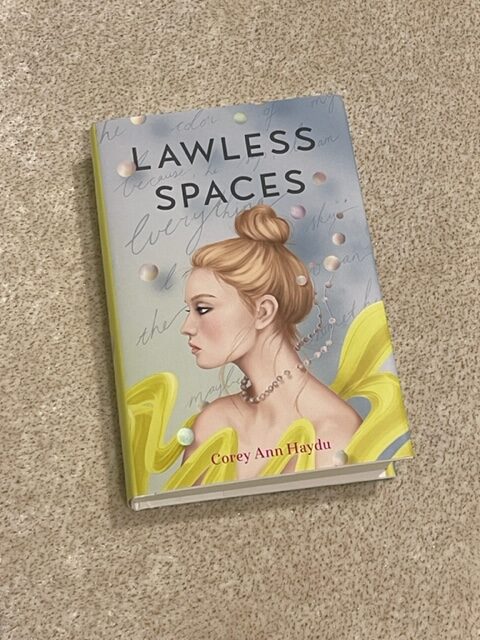 Poetry was a wonderful choice for Haydu’s poignant, heart-wrenching, and ultimately hopeful novel. It is raw, sometimes painful, and relatable to anyone who has ever felt trapped in their lives (such as during a pandemic), or trapped in/defined by their bodies, or powerless to speak out and make necessary change. Haydu explores mother/daughter relationships and all they entail (body image, power dynamics) across generations with courage and care, something that resonates with readers and reviewers alike.
Poetry was a wonderful choice for Haydu’s poignant, heart-wrenching, and ultimately hopeful novel. It is raw, sometimes painful, and relatable to anyone who has ever felt trapped in their lives (such as during a pandemic), or trapped in/defined by their bodies, or powerless to speak out and make necessary change. Haydu explores mother/daughter relationships and all they entail (body image, power dynamics) across generations with courage and care, something that resonates with readers and reviewers alike.
Haydu’s love of craft, her insight, and the amazing questions about living and life that she explores through her work give readers and writers alike a lot to ponder. Read on for her thoughtful and inspiring answers to our recent email Q & A:
What made you make the foray to writing a verse novel, and how did you prepare for that?
I’ve honestly always wanted to write in verse! Back in college my dream was to be an actress who published poetry on the side, and though many things changed about that dream over the years, my connection to poetry and the way a poem can so succinctly capture a moment and a feeling and get to the heart of things has remained the same.
I’ve been reading novels in verse basically since I first started reading in YA, sort of keeping in my back pocket the idea of them, loving that they existed, wondering if maybe I would get to wander over and try them myself some day. So the preparation was mostly that– years of reading them, and being excited by them, and understanding what makes them work. When it was time to actually write one of my own, I took it very slowly, just letting myself play with the form, long hand, and without a concrete plan for many years. It really helped to let myself stay in that exploratory phase for a long time.
 You now have various works published across so many genres (chapter books, middle grade and young adult novels (prose and verse). From creative and business standpoints, what have been the upsides of writing in so many different genres? Any challenges?
You now have various works published across so many genres (chapter books, middle grade and young adult novels (prose and verse). From creative and business standpoints, what have been the upsides of writing in so many different genres? Any challenges?
It’s hard to speak professionally, because I think that side of things is so unpredictable, and I tend to be a terrible judge of what will do well out in the world. But emotionally speaking, it has helped me a great deal to not have too much pressure on any one age category. My goal is always to get to focus on the writing– it’s the part of things I enjoy, and it’s the part I’m good at and suited for. And writing in multiple age categories lets me worry less about each individual book, once it’s out in the world. I worry about them a great deal when they’re in my hands, but once they come out, I’ve learned to let them go a bit, and focus on what’s next. There have been times my YA hasn’t been finding the readership I’d hoped for, and that’s why my middle grade started finding its space, and I’m so grateful I had that positive trajectory to focus on when certain books weren’t doing what I’d hoped.
Creatively, this is really just who I am. I like to try everything, writing-wise, I like to be challenged, and I’m inspired by every aspect of children’s publishing and storytelling generally. Feeling expansive and creative and out of my comfort zone really feeds me, and so far I have yet to get bored. I also have to say I’ve been incredibly lucky to have a supportive agent and supportive editors, who never told me I had to stay in one place. I’ve been encouraged to move around and explore other parts of my voice, and I don’t know why I’ve been given that chance, but i’m so glad I have, because it’s really how I work best.
 How has the pandemic impacted your writing life in terms of finding time and being in the headspace to do your best work? You’re obviously prolific and productive despite it all, so what has been most helpful to you in terms of getting it done?
How has the pandemic impacted your writing life in terms of finding time and being in the headspace to do your best work? You’re obviously prolific and productive despite it all, so what has been most helpful to you in terms of getting it done?
My number one current advice, especially for writers who also happen to be parents, but really for anyone who has a lot of demands on them in the home and is struggling to find their way creatively, is to get up early. I discovered 5am writing during the pandemic out of necessity– my toddler couldn’t handle me working while she was at home– and over the last two years every time I’m in a creative slump, I reintroduce that practice to myself. There’s something about writing before I have to be anyone else– a parent or a wife or a friend or a person in the world in any meaningful way– that really clarifies the work for me. I work faster, and better, and more enjoyably. I have found I need that, even though it can be tough. Once I’ve put on the parenting hat, it’s harder to transition into a creative space. So getting up very early is a gift I give myself as often as I can.
What was the spark for Lawless Spaces, and what do you hope readers glean from it?
I have long wanted to write a novel that follows mothers and daughters, that somehow tracks the things they are dealing with across generations. Maybe it all began with Gilmore Girls, and the incredible trifecta of Emilly, Lorelai, and Rory, and getting to see how baggage gets passed on and how it shifts and becomes something new. I have always wanted to understand that personally– and especially as I’ve become the mother of a daughter, those questions have gotten louder and more consuming for me. Once I started on that track, I realized it was time to write about a lot of things from my own life I hadn’t really addressed previously– specifically being a young girl in the entertainment industry, and living in a petite and curvy body, and how those things intersect with generational relationships and your own relationship with yourself. It was really an organic process, ultimately, where I found so much joy and healing.
As one of your former students who had the privilege to work with you, one of the things that most impresses me is your willingness to take risks in your writing, to wear your heart in so many of your gorgeous words, and your desire to keep pushing and keep learning. What books, films, music, craft resources etc. have influenced, helped, and inspired you most?
Honestly, poetry was a huge part of my teen years, when I was acting and writing, and also just struggling to put feelings into words and struggling to be understood. I was always deeply connected to the work of Sylvia Plath, as well as Pablo Neruda, Anne Sexton, and e.e. cummings. I loved their fearless and emotionally-forward approach to their work, and it not only resonated with me but helped me through really challenging times. Early on I was really blown away by Sandra Cisneros’ HOUSE ON MANGO STREET, which helped me understand the importance of small moments telling a bigger story. I’ve always been drawn to art that addresses difficult topics and challenging relationships. I was an actor, with a real affinity for the tragedy of THE GLASS MENAGERIE or the high-stakes ugliness of relationships in NO EXIT or the absurd takes on life of Christopher Durang’s work. I practically lived inside The Counting Crows’ first album, AUGUST AND EVERYTHING AFTER, which is a lyrically really heartbreaking and beautiful collection of songs– I loved how language and vulnerability combined to really make me feel understood in my pain.
I operate sort of heart-first, emotions-first with my work, and I certainly learned that from knowing what I connected with, and more than that probably what I needed. And that remains true– I like work that challenges me and stories that make me uncomfortable and language that makes me think about something anew. I’m also a collaborator, so I’ve been really influenced by the editors I’ve worked with, who have been really game to help me try new things and stretch into new spaces. I’ve found that caring more about learning than about being good at something is a real gift in a creative life. 🙂
Anything else you’d like to share?
Thanks so much for a such a smart, interesting collection of questions, and I hope the readers who are interested in the same things I’m interested in– bodies and mothers and daughters, and generational trauma, and how to push against the way the world sees you to be able to instead occupy the space that feels right for you– find LAWLESS SPACES. It was one of my favorite books to write, and I said so much I’ve been wanting to say, which always feels good.
To learn more about Corey Ann Haydu and her work, visit her website here. Lawless Spaces and her other books are available at Indiebound, Barnes & Noble, Amazon, or wherever books are sold.
Corey Ann Haydu is the author of many critically acclaimed middle grade and young adult novels, including EVENTOWN, RULES FOR STEALING STARS, EVER CURSED, and OCD LOVE STORY. She is also the author of the HAND-ME-DOWN MAGIC chapter book series. Corey is a graduate of NYU’s Tisch School of the Arts and The New School’s Writing for Children MFA program, and has been working in children’s publishing since 2009. In 2013, Corey was chosen as one of Publisher Weekly’s Flying Starts. Her books have been Amazon Book of the Month Selections, Junior Library Guild Selections, Indie Next Selections, and BCCB Blue Ribbon Selections. In 2020, she received an Edgar Award Nomination for her novel EVENTOWN. Corey is also a proud faculty member of the Vermont College of Fine Arts’ MFA in Writing for Children and Young Adults program. Corey lives in Brooklyn with her husband, her daughter, her dog, Oscar, and a wide variety of cheese.
Elisa Zied a writer for young people. She holds an MFA in Writing for Children and Young Adults from Vermont College of Fine Arts and an advanced Graduate Certificate in Children’s Literature from Stony Brook Southampton. She also earned a BA in psychology from University of Pennsylvania and an MS in clinical nutrition from New York University. Before embarking on a fiction writing career, she garnered millions of media impressions as a nutrition expert, spokesperson, and freelance health and nutrition writer. She also authored four award-winning nutrition titles including YOUNGER NEXT WEEK (Harlequin Nonfiction, 2014) and NUTRITION AT YOUR FINGERTIPS (Alpha Books/Penguin, 2009). She lives in New York City with her husband and two sons and is an avid walker, music lover, and amateur photographer.
by Elisa Zied | Oct 23, 2021 | books, fiction, writer, writers, writing, young adult books
If you’re looking for an immersive, beautiful and expansive story about friendship (with romance), Laura Taylor Namey’s third novel, When We Were Them (Atheneum Books for Young Readers, November 16, 2021), more than fits the bill. Told over the course of one week and laced with rich memories and moments between three friends, the story is sure to resonate with teens and adult readers alike who have experienced or aspired to have deep, meaningful relationships.
Here’s a description of the novel from Taylor Namey’s website:
When they were fifteen, Willa, Luz, and Britton had a friendship that was everything.
When they were sixteen, they stood by one another no matter what.
When they were seventeen, they went through the worst.
And when they were eighteen, Willa ruined it all.
I had the pleasure of doing a Q & A with Taylor Namey, an author I’m also proud to call a friend since we met years ago at the SCBWI annual conference in Los Angeles. Here are the highlights from our email exchange.
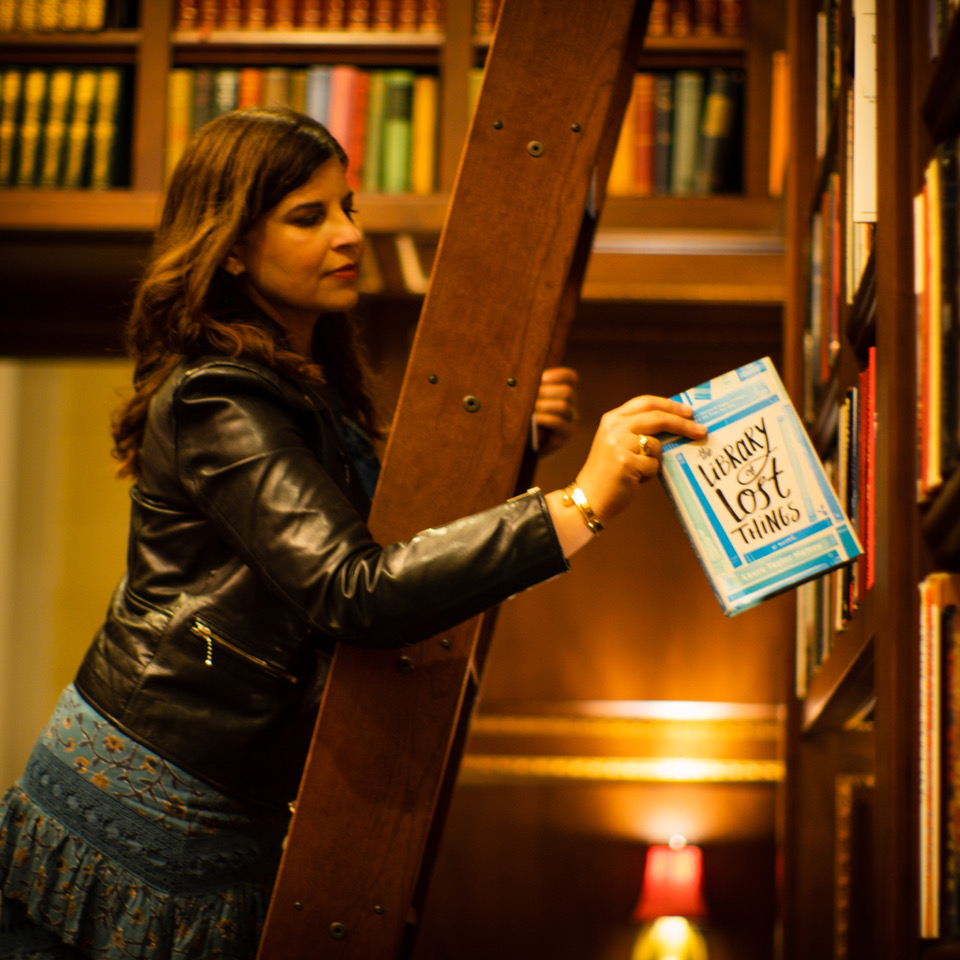 In what ways has your writing process and daily practice changed since writing your debut novel, The Library of Lost Things?
In what ways has your writing process and daily practice changed since writing your debut novel, The Library of Lost Things?
Now that my children are older, I definitely have more time to work in longer chunks, but my workload has increased ten-fold. I think what has changed the most is having to adapt to various seasons. My day looks much different when I’m actively drafting to other times when I’m focusing mainly on promotion or editing. My new motto is a combination of a day-by-day mentality as well as completing new tasks as quickly as I can, so they don’t pile up.
What was the spark for your latest novel, When We Were Them, and what made you want to explore female friendship?
After writing two coming of age YA novels with heavy romance subplots, I wanted to stretch my wings a little and try something different. WHEN WE WERE THEM is my most complex work to date, but I felt ready for a challenge. Having a brilliant editor who knew how to push and bring out my best made all the difference.
While A Cuban Girl’s Guide to Tea and Tomorrow is a tribute to my Cuban family, WHEN WE WERE THEM is an ode to my California beach girl childhood. I set the novel in the small community where I grew up. As a teen, my female friends and those relationships were so crucial to my identity and development. I wanted to celebrate a ride or die friendship between three teen girls, but also explore the way grief and loss and growing up can affect relationship, as well as the fallout that ensues when one girl leans too hard on the others. The novel asks the question, is everything they were strong enough to survive everything they’ve become?
While all of WWWT comes from you, which specific parts of which characters are most like or drawn from your family and friendships (childhood and/or current)?
These three characters and their friendship contain bits of me, in contrast to the character of Lila Reyes from A Cuban Girl’s Guide to Tea and Tomorrow. She embodies most me as a teen. Future opera star Britton shares my love of music, and Luz’s obsession with the heart and the human body and medicine is a tribute to my father who passed away from heart disease. Willa’s surfer girl and ocean loving spirit comes right from my childhood. I grew up on the beach featured on the cover.
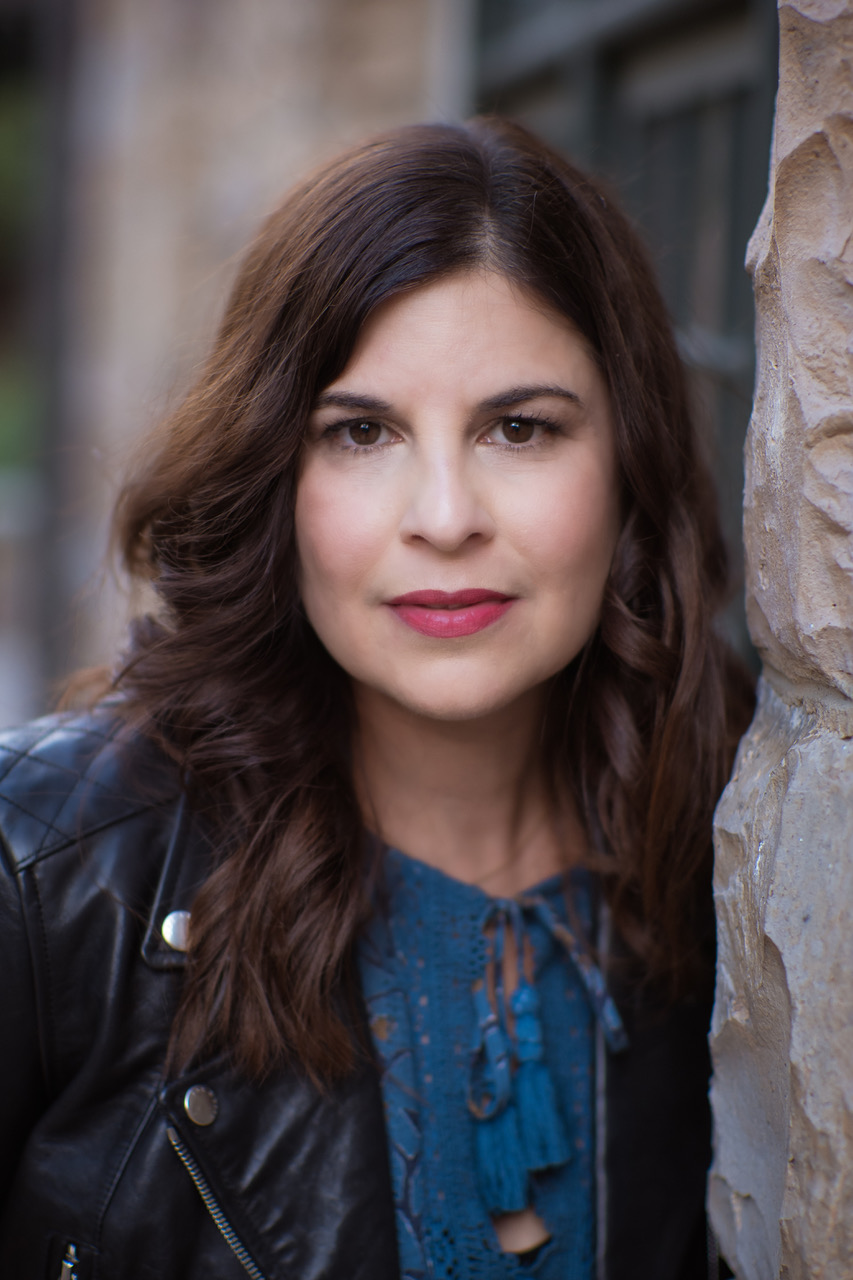 You dive deep into the ocean (pun intended), medicine, opera, becoming a Navy SEAL, and so much more in your novel. What did you know about each of these ahead of time, and what kind of research did you have to do before/while writing WWWT?
You dive deep into the ocean (pun intended), medicine, opera, becoming a Navy SEAL, and so much more in your novel. What did you know about each of these ahead of time, and what kind of research did you have to do before/while writing WWWT?
I knew very little about each of these aspects of my book, beyond surface level, before I started researching. Growing up in San Diego, I was familiar with Navy SEALs, used to live next door to a former SEAL. But it took interviews with active military personnel and a lot of reading to educate myself well enough to be able to include this experience in my story. The rest just took time and study, and a lot of YouTube watching. I particularly enjoyed watching hours of opera masterclasses and teaching sessions filmed at universities. Opera is such a gorgeous art form and it was a privilege to include a bit of this rep in my story.
You seem to be a master of juggling book drafting and revision as well as book promotion. What’s your typical schedule (or secret)?
Thank you! When I’m in a drafting or promotion season, or lately, both at once, I work between eight and ten hours a day. I draft in short 45-minute increments, spending the last fifteen minutes of every hour answering emails, prepping material for workshops, or maintaining my social media accounts. After dinner, I’m usually reading or working on my critique partners’ work. I’ve tried to be better about taking weekends off, but the month before a new book comes out, I typically have to spend a few weekend hours catching up. Despite the long hours, there is nothing I’d rather be doing.
Anyone who knows you knows how connected you are to your two critique partners. How has that relationship evolved and grown as you’ve all moved from pre-published writers to agented and/or published authors?
Now that the three of us have worked on multiple projects over the last three and a half years, I feel we’re better equipped to provide support, developmental feedback, and pinpoint editing within our workspace. We are the best of friends and mutual cheerleaders, and we trust each other implicitly. I am so lucky to have them.
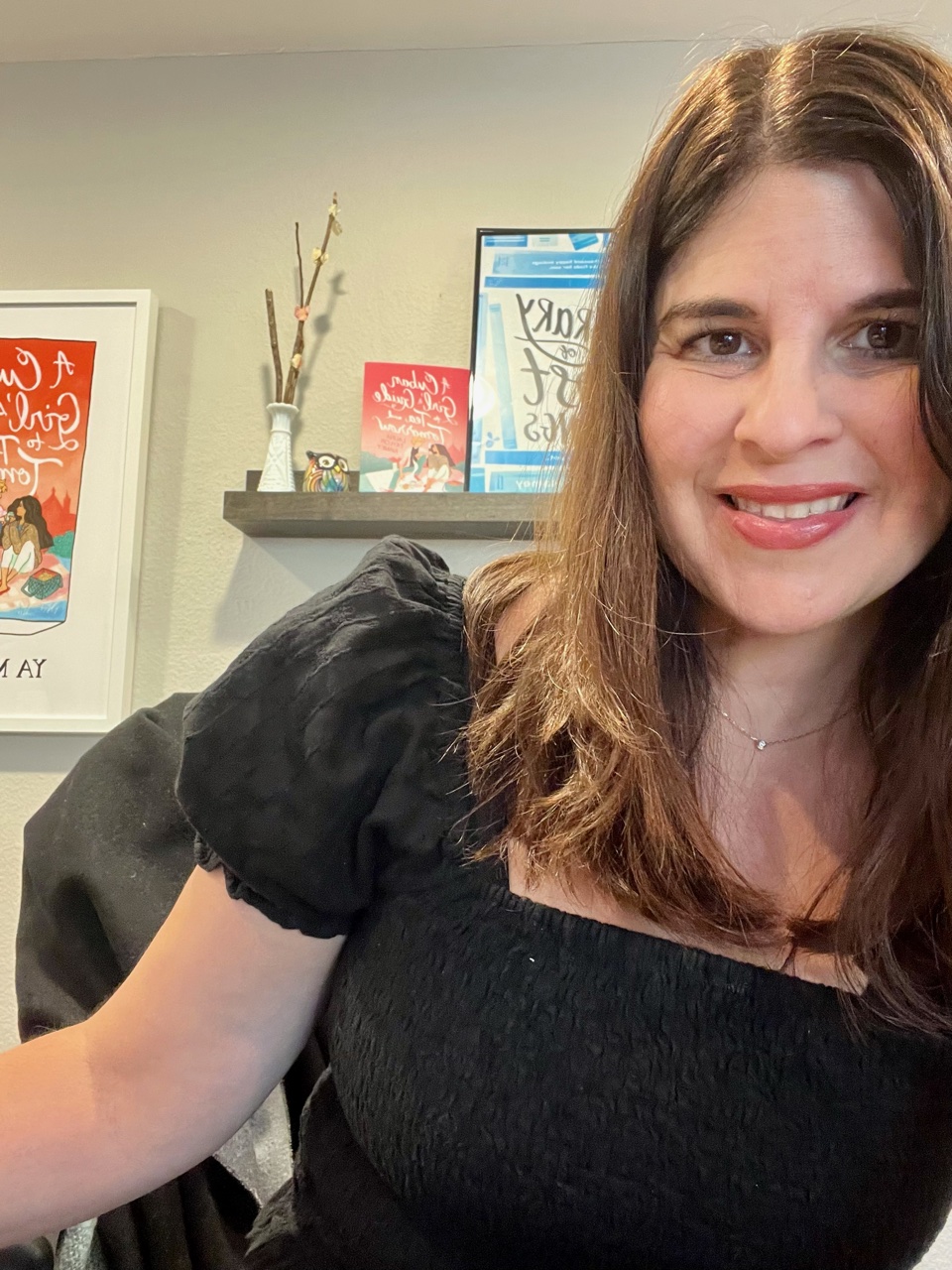 What was the best part about having your sophomore novel, A Cuban Girl’s Guide to Tea and Tomorrow, become a Reese’s YA Book Club pick—and a New York Times bestseller?
What was the best part about having your sophomore novel, A Cuban Girl’s Guide to Tea and Tomorrow, become a Reese’s YA Book Club pick—and a New York Times bestseller?
Being chosen for Reese’s Book Club has truly been one of the highlights of my career. The entire team is wonderful and so supportive, and the club works like a big family. I love being able to share my book across a wider platform and audience.
What has been the most challenging aspect of publishing three books in two years? And what have you learned about yourself as a writer (and a person) during that time?
Having to juggle multiple projects at once has been hard. Setting aside a draft to work on another book that might be in a different stage can be tricky. Now, I’m used to it. I’ve learned that I have a unique process that works for me and my writing style. And I’ve learned how much I truly love this job. The work is hard and long and taxing at times, but it is the only work I want to be doing.
What are some tips you have for aspiring writers to help them find ideas/inspiration for stories they’re meant to tell?
The world and the people you meet simply by living your life can provide so much inspiration. I’m also a fan of combining story ideas. The memory of a high school friend, plus a sparkling event three years ago, plus a curious letter or single line overheard at a café can be combined to create a thrilling new story. Also, ideas breed other ideas if you give them space. Jotting notes about story tidbits can unleash your creativity and many times, your mind will expand the scope of a few loose ideas into a novel worthy premise and a compelling tale.
Please share a favorite prompt or two for writers to help them get started on a new idea, or to get to know their characters better (especially those like me who are doing Nanowrimo in November).
My favorite exercise to get to know my character better is a long check list that I fiddle with before I start my book. Here is an abridged version. You should be able to answer these questions in your character’s voice.
I want most to:
I could have that except:
I am thrilled by:
I am inspired by:
I am terrified by:
I am disgusted by:
I’m most centered when:
I’m most anxious when:
My personal style looks like:
Not counting my pets, or family members, if I could only save three objects in a fire, I’d choose:
What are some of your favorite recent reads, TV shows, films or songs/albums?
Some recent favorite reads are You’d Be Home Now by Kathleen Glasgow, People We Meet on Vacation by Emily Henry, and Our Way Back to Always by Nina Moreno.
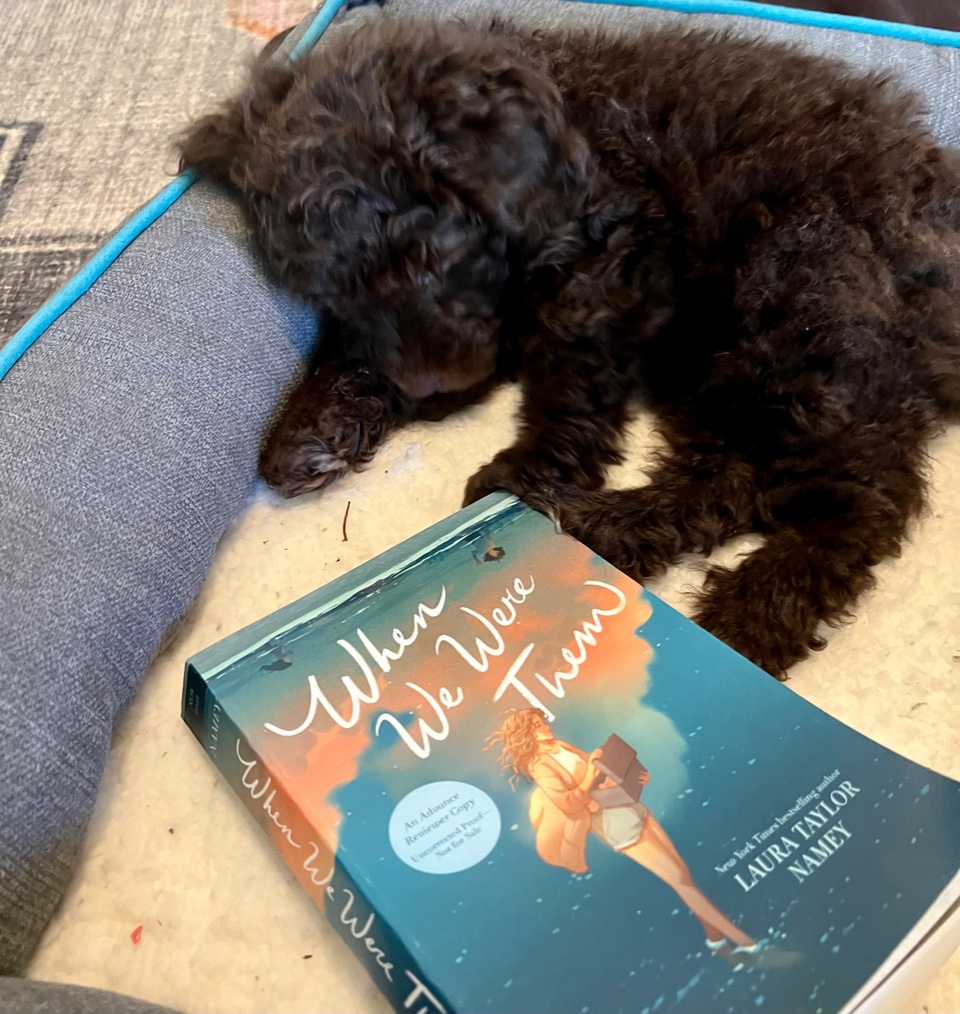
Professor Henry Higgins (aka Henry) is a big fan of his mother’s new novel!
Laura Taylor Namey is the New York Times bestselling author of Reese’s Book Club pick A Cuban Girl’s Guide to Tea and Tomorrow, The Library of Lost Things, and When We Were Them. A proud Cuban-American, she can be found hunting for vintage treasures and wishing she was in London or Paris. She lives in San Diego with her husband and two children. To learn more about Taylor Namey and all her work, visit her website here. You can order her books wherever books are sold, and check out her preorder campaign with Mysterious Galaxy Books in San Diego here.
by Elisa Zied | Sep 25, 2021 | books, fiction, writer, writers, writing, young adult books
You’d Be Home Now (Delacorte Press, September 28, 2021) is already a STAR. Kirkus calls the latest novel by bestselling author Kathleen Glasgow “A gut-wrenching look at how addiction affects a family and a town,” and “Necessary, important, honest, loving, and true.” Also praised by Booklist, and School Library Journal, this fantastic find according to Shondaland is at the top of my TBR list. I devoured Glasgow’s first two novels, Girl in Pieces and How to Make Friends with the Dark, and am especially excited for her latest work (which, for better or worse, makes me think of my own childhood). I have no doubt it will resonate with young adults and not so young readers alike. Here’s a brief description of You’d Be Home Now:
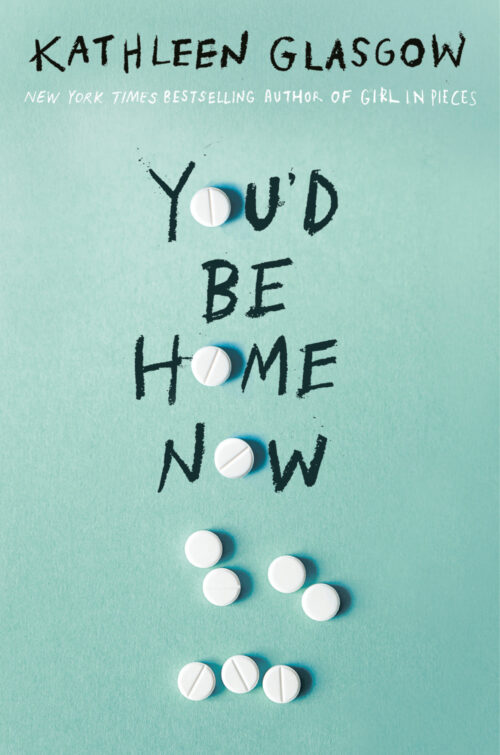 No one knew just how bad Joey Ward’s addiction was until the night Candy MontClaire died. Four months later, he’s back from rehab, hoping for a fresh start in a town that doesn’t know how to forgive. His sister, Emory, is tasked as his keeper. Because in a family with a “beautiful one” (her glamorous and outgoing older sister Maddie) and a “bad one” (Joey), Emmy has always been “the good one.” Of course she’ll keep her brother safe. She loves Joey more than anything. She’ll do anything to keep him alive.
No one knew just how bad Joey Ward’s addiction was until the night Candy MontClaire died. Four months later, he’s back from rehab, hoping for a fresh start in a town that doesn’t know how to forgive. His sister, Emory, is tasked as his keeper. Because in a family with a “beautiful one” (her glamorous and outgoing older sister Maddie) and a “bad one” (Joey), Emmy has always been “the good one.” Of course she’ll keep her brother safe. She loves Joey more than anything. She’ll do anything to keep him alive.
But what if love isn’t enough to save someone?
Glasgow was kind enough to do an email Q & A for my blog. Read on to learn more about her latest novel and her writing life.
What was the spark for You’d Be Home Now? And did you know from the get-go you wanted—or had to—write about a teen girl tasked with picking up the pieces after her brother’s drug addiction?
You’d Be Home Now was inspired by Thornton Wilder’s classic play, Our Town. It’s a loose reimagining of Grover’s Corners and what a town like that might be like today. If Wilder wrote the play today, I have no doubt the opioid crisis would be part of the plot, as this epidemic has ravaged families, towns, and communities. I chose to write the book from Emmy’s POV because there’s collateral damage in addiction: families, particularly siblings, who often become overlooked, overwhelmed, and exhausted in the face of a sibling’s addiction. The impact of addiction touches everyone in a family and really does a number on their mental health. They deserve a story, too.
I’m intrigued by the idea of examining who we are and what role we play within our families and our communities, and how that impacts our relationships and self-perception. I, for example, have always been a rule-follower who sought others’ approval, and who was always considered to be ‘the good one.” My older brother who was frequently in trouble was deemed “the bad one.” (We’ve been estranged for more than 15 years, and obviously haven’t worked through those narratives—maybe someday?!) What made you want to explore this idea in your novel, and did you have any revelations (in general or about your own life) along the way?
Everyone, for better or for worse, gets slotted into a role in a family: “the good one,” “the troubled one,” “the beautiful one,” “the difficult one.” It’s endless. But it’s not who each kid is, it’s who they are being defined as, and that’s not fair to any of them, because it makes them suppress emotions and not feel comfortable moving out of the role they’ve been assigned, if that makes sense. In YOU’D BE HOME NOW, Emmy is “the good one.” Quiet, rule-follower, caretaker of Joey since she was very small. In essence, because of this role, she’s never really discovered who she really is, or what she really wants out of life, or even how to get it. She doesn’t have an identity she forged on her own; it was given to her by her family. And of course, she wants to help her brother. But at what cost? She also wants to live a life of small, normal joys, like having a boyfriend, or going to dance. Those things make her feel guilty, though, because how can she enjoy herself while her brother’s life is disintegrating? I tried to be very careful in the book about Emmy’s journey with Joey, because she’s at the very beginning of this struggle with Joey, and many people (especially older readers) have reached a sort of end with the Joeys in their lives: they can no longer give all they’ve got; they’re exhausted. And that is valid! The question is learning to set your boundaries: what you can do, what you can’t do, because in the end, you also have to take care of yourself. It’s Emmy’s struggle in the book to realize this. I wanted to show the process of taking care of yourself, too. And to stop assigning people roles that don’t actually define who they are.
How was the process of writing this third novel different from that for Girl in Pieces, and How to Make Friends with the Dark?
Well, it was very hard to write with Thornton Wilder in the room! But I eventually overcame that, because the story became its own. I would say writing this book was different because Girl in Pieces and How to Make Friends with the Dark are pure emotion—Charlie and Tiger’s POVs are very interior and heavy. I needed to make Emmy’s narrative somewhat less intense than my other books to stretch the story beyond Emmy and into the town and the school to show how the tentacles of addiction ensnare everyone, not just the person struggling with addiction. An Instagram poster in the book called Mis_Educated is a character in the book and through their posts, a reader also gets a chance to hear from kids in the town of Mill Haven (in the comment section) about what’s really happening and how they feel about their lives.
How has the pandemic changed your writing life in terms of practices and inspiration?
I don’t know if the pandemic has changed my writing practice or inspiration so much as it has changed me, slowly, over time. I’m already an introvert and being even more isolated during the pandemic led me back into a deep depression. I wasn’t writing at all for several months, actually, until a joke between me and fellow author Liz Lawson (The Lucky Ones) turned into . . . a book. I needed something fun and different, I needed something to look forward to every day, and so did Liz, and those Twitter DMs between us eventually turned into a mystery called The Agathas, which comes out May 2022. Writing that book quietly with Liz, with no one watching (we didn’t tell our agents for a long time), really lifted me to a better place. And it’s a different tone of book for us, as both Liz and I tend toward heavier topics. We kept everything speedy, and fun, and about friendship (two teen girls become unlikely detectives and even more unlikely, become friends) and it was really a balm for me.
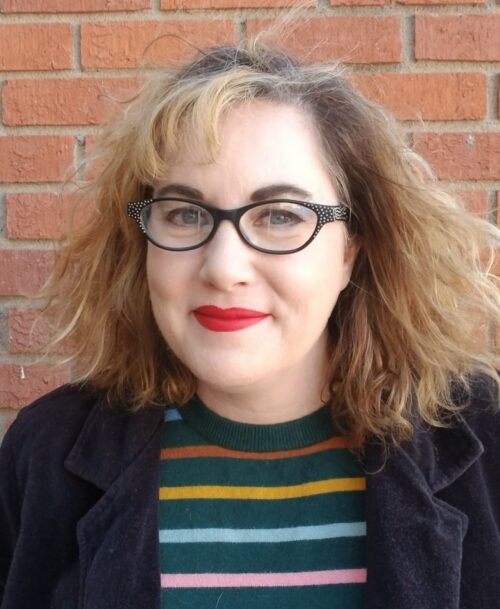 What has been the most rewarding part of being a young adult novelist? What has been the most challenging part?
What has been the most rewarding part of being a young adult novelist? What has been the most challenging part?
It’s rewarding in the sense that I hear every day from readers who have discovered Girl in Pieces and How to Make Friends with the Dark that those books have touched them deeply. I can’t really articulate what it means to know your book has impacted someone’s life in a deep and meaningful way. It makes me want to cry, actually! I’m grateful for that interaction. Writing is often hard and lonely, and sometimes you just don’t know if the story will land, especially with teens. I would say a challenging part is trying to do my best by teen readers and to articulate the adolescent experience in an authentic and believable way. And to give them a good and satisfying story to read.
What advice (in terms of craft or process) do you have for writers just starting out?
I don’t know if I’m an expert on anything having to do with writing, actually! I just try and write when I can, when a story keeps nudging me and won’t quit. I think in practical terms of craft, reading widely and often is the best teacher. You can learn from re-reading books you love: how the author structured this, how they handled that, how they went from A to B. I will say that you’ll learn what works for you in the beginning and then as you continue to write, you’ll improve through practice. I think the hardest thing for beginning writers is how to start. Like, literally, how to find time to sit in a chair (or couch, or bed, or coffee shop) and . . . get those first few words down. There’s a real fear: who am I to call myself a writer? Well, if you write, you’re a writer! And there’s a fear of: what if this isn’t any good? My answer to that is: what is good? One person might like your story, one might not. You can’t control that. But the most important thing to remember is, those things are abstract in the beginning: if you don’t sit down and write that story, no one will be able to read it. And believe me, someone wants to! Of that, I’m sure. We writers have a hard time getting out of our own way! We can imagine a million things might happen after we write a story and send it into the world, but if we don’t write it first, we will never know if any of those million things come to fruition.
What books, TV shows, and music have you most enjoyed during the pandemic (and more recently)?
I tend to have the television on in the background when I write and I wrote the entirety of You’d Be Home Now with Grey’s Anatomy on an endless loop. The shows I watched in the past two and half years when I WASN’T writing include (and I’m sorry on some of these because often it takes me years to watch a show everyone watched fifteen years ago): Game of Thrones, Mad Men, The Wilds, The Sopranos (could not finish, too many dream sequences), The Wire, 30 Rock, The Crown, Breaking Bad, Big Mouth, Forensic Files, Cold Cases, PEN15, Broadchurch. Some of my favorite books to read this past year were: The Lucky Ones (Liz Lawson); Never Saw You Coming (Erin Hahn); Something Happened to Ali Greenleaf (Hayley Krischer); When We Were Strangers (Alex Richards); That Weekend (Kara Thomas); The Project (Courtney Summers); Off the Record (Camryn Garrett). That’s just a small list. My music listening is all over the place, but lately I can’t stop listening to a song by Bright Eyes called “At the Bottom of Everything.” A weird thing about me is that while I don’t listen to music AS I write, I actually can’t start physically writing a book until I have everything in my head AND I have found the song that kind of drives the story, and “At the Bottom of Everything” is the song that drives what I hope will be my fifth book. (Girl in Pieces was “Kamera” by Wilco; How to Make Friends with the Dark was “Sign of the Times” by Harry Styles; You’d Be Home Now was “Let You Down,” by NF).
You’re a master storyteller, especially because you manage to inject hope into all of your stories no matter how raw, emotional, and painful they may have been to write or read. What’s one thing you’ve learned through your life and/or writing—especially during these especially challenging times—that has helped you persevere and continue to push through and make your art?
Honestly, I don’t know what else I would do if I couldn’t write. It’s all I’ve ever wanted to be, a writer. And stories are what keep us all going, right? When do we ever not need a good story?
About Kathleen Glasgow: She is the New York Times bestselling author of Girl in Pieces, How to Make Friends with the Dark, You’d Be Home Now, and the upcoming The Agathas (with Liz Lawson) (Delacorte, May 2022). She received her undergraduate degree from the University of New Mexico and her MFA from the University of Minnesota. She lives in Tucson, Arizona.
Check out my previous Q & A with Kathleen Glasgow for the launch of How to Make Friends in the Dark. And learn more about Glasgow and her work on her website. Her wonderful work is available wherever books are sold.
by Elisa Zied | Jul 25, 2021 | books, fiction, graduate school, MFA, writer, writers, writing, young adult books
Full disclosure: Emma Kress is my dear friend. During our MFA studies, my Revisionary cohort at Vermont College of Fine Arts was lucky enough to adopt her (though we all respected the fact that we’d forever have to share her with the Tropebusters). Despite my obvious bias, this teacher and writer can only be described as a force, both as a human and a novelist. She has a lot to say and says it all with heart and hope and humor. Her powerful debut novel, Dangerous Play (Roaring Brook Press, August 3, 2021), more than proves that.
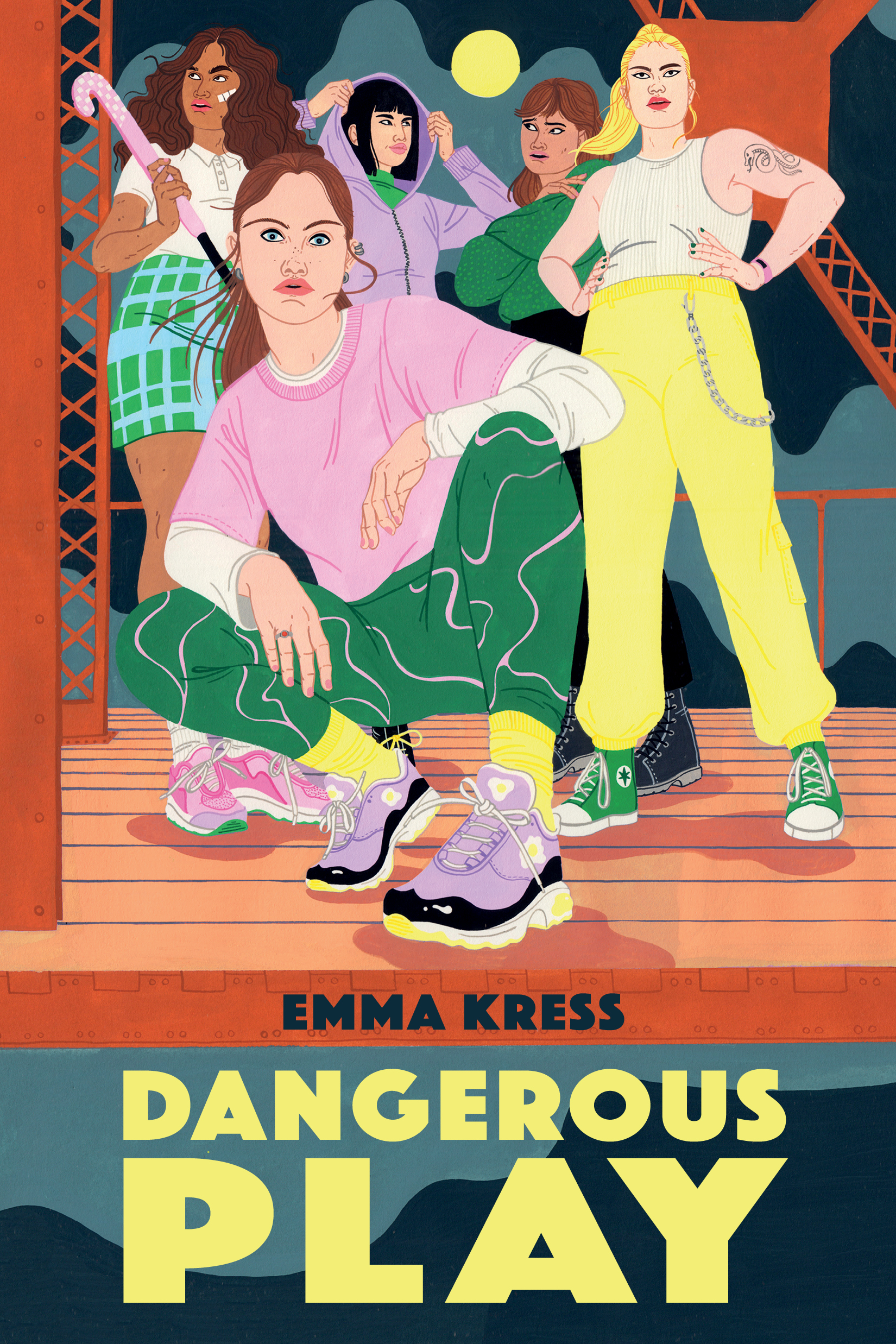 Described by Kirkus as “[A] contemporary feminist debut. . . . A timely and absorbing character study of a sexual assault survivor,” and by Corey Ann Haydu, author of Ever Cursed, as “Vibrant, daring, and deep, Dangerous Play is both a thrilling ride and a profound exploration of female friendship, rape culture, and the difficulty of doing the right thing in a world built on wrongs. An unflinching and empowering debut,” the novel is a timely, gripping and thought-provoking must-read for teens.
Described by Kirkus as “[A] contemporary feminist debut. . . . A timely and absorbing character study of a sexual assault survivor,” and by Corey Ann Haydu, author of Ever Cursed, as “Vibrant, daring, and deep, Dangerous Play is both a thrilling ride and a profound exploration of female friendship, rape culture, and the difficulty of doing the right thing in a world built on wrongs. An unflinching and empowering debut,” the novel is a timely, gripping and thought-provoking must-read for teens.
Here’s a brief description of the novel from Emma’s website:
Zoe Alamandar has one goal: win the State Field Hockey Championships and earn a scholarship that will get her the hell out of Central New York. She and her co-captain Ava Cervantes have assembled a fierce team of dedicated girls who will work hard and play by the rules.
But after Zoe is sexually assaulted at a party, she finds a new goal: make sure no girl feels unsafe again. Zoe and her teammates decide to stop playing by the rules and take justice into their own hands. Soon, their suburban town has a team of superheroes meting out punishments. But one night of vigilantism may cost Zoe her team, the championship, her scholarship, and her future.
I had the pleasure of doing an email Q and A with Emma about the novel and her writing life. Here are the highlights:
When did you know you were a writer, and at what point did you decide you’d write for children and young adults?
I’ve wanted to be a writer since I was ten but it took me until 2010 to take my writing seriously and commit to a daily practice. Writing for children and young adults was a natural choice as I was a teacher, surrounded by both children and children’s literature. At the start of my teaching career, I taught 5th grade and started a few middle-grade books. By the time I was writing seriously, I was teaching teens and reading a lot of YA fiction. But it was more than proximity, I think, that drew me to write for children and young adults. I think it was the same thing that drew me to teaching children and teens: our society underestimates kids, trivializes their concerns, and romanticizes their experience, all while exerting a lot of control over their existence. As a result, giving space on the page to teens and children is a radical act of resistance. And, most of my favorite stories center around change and power. I don’t think there’s any period of life that hits those more than childhood and adolescence.
What’s the greatest source of joy and fun for you when it comes to your writing life?
I love to learn and grow and writing offers a great path to both. I love figuring out the way the world or people work, though the eyes of my characters. I love the way a character can surprise me even though, technically, I’m the one doing the writing. I love the way at some point during the writing process I recognize some deep psychological struggle and get to say, “oh, that’s what you’re about.” Writing for me is like how running is for my husband—it keeps me steady, it keeps me sane. And, um, I don’t even need to sweat.

How has teaching fed into your creative life/process?
I think my love of teaching and the kids I’ve taught has been very helpful in terms of character voice and dialogue. I also feel very present in that time of life. I don’t have to rely on my memories as a teen when students are so ready to say, “you’ll never believe what just happened in the hall.” As a result, I think my stories feel authentic and of this moment. But I also think my commitment to honoring the voices and experiences of children and teens as a teacher is the same thing that drives me as a writer. As I said earlier, I think it is a radical act of resistance to listen to and honor children and teens.
How did getting your MFA at VCFA change your life (writing and otherwise)?
I could wax poetic about all that I love about VCFA for yeeears. VCFA gave me so many tools to improve my writing. As a result, I’m so much better at story structure, character development, side writing, and precision. But my time at VCFA was so much more for me than just a Home Depot for writing tools. VCFA emboldened me to experiment with new genres and audiences. VCFA fed my confidence and helped me pinpoint my strengths while shoring up my weaknesses. And I was actually shocked by the close-knit community. The alums I’d spoke to before I went all talked about it, but somehow, I didn’t think it would apply to me. Wow, I was wrong. It’s such a powerful network of talented and beautiful humans. I’d never been a part of an institution that was built on the twin pillars of compassion and creativity. As a teacher and former administrator, it was incredible to see that in action.
What are three tools you’ve used or created to help draft your novels?
My three biggest tools that I’m obsessed with right now:
- side writing
- working out problems with fat markers on big chart paper
- graph paper spreadsheets (not on the computer)
(For me, a big way to solve problems is often to step away from the manuscript and get off of the computer.)
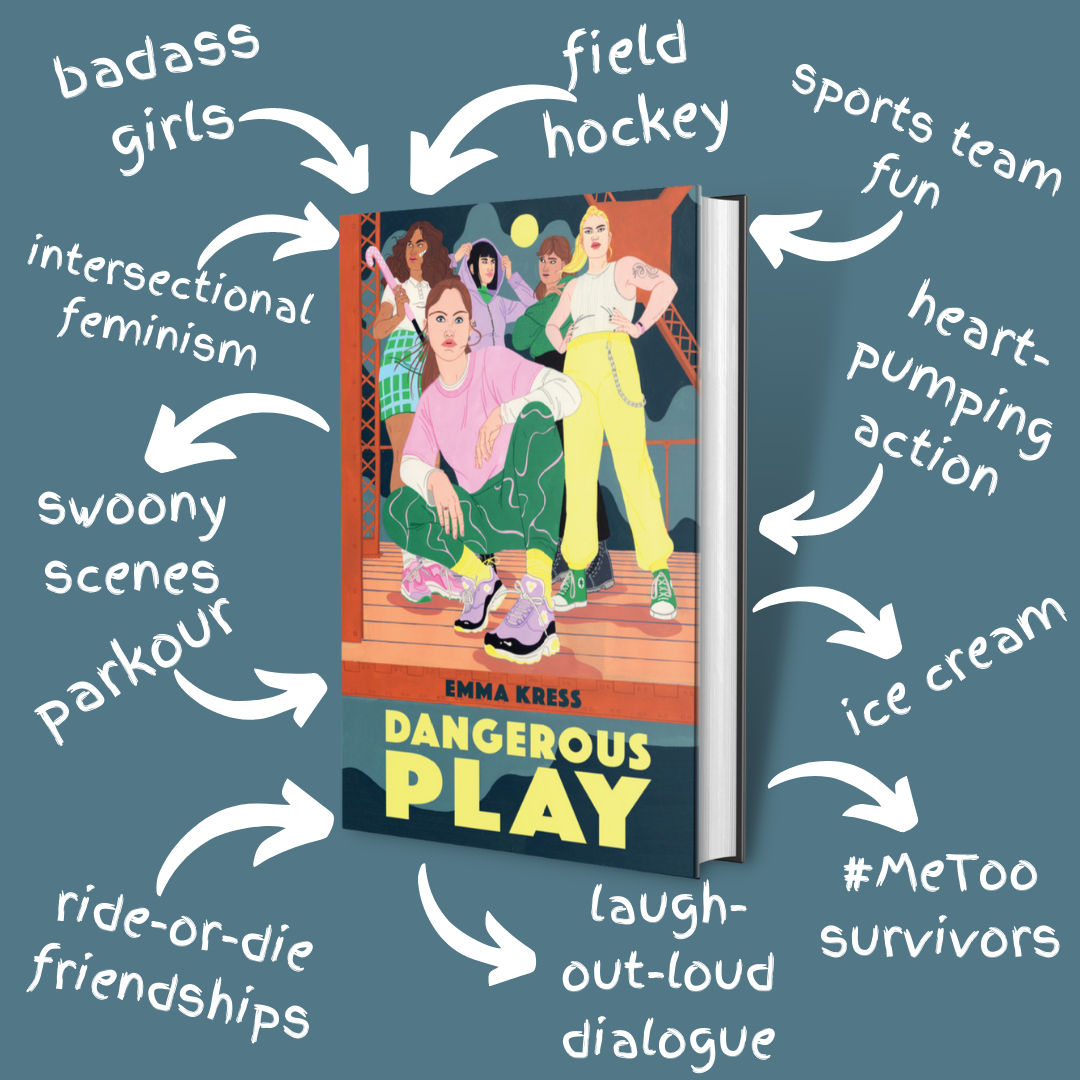 What was the spark that led to Dangerous Play, why was it important for you to write this particular story, and what did the process from spark to book look like?
What was the spark that led to Dangerous Play, why was it important for you to write this particular story, and what did the process from spark to book look like?
Dangerous Play is about the captain of a girls’ field hockey team. When she’s sexually assaulted, her ride-or-die team turn into vigilantes…but it might cost them everything.
This team of fierce, hyper-athletic, determined girls showed up when I was in the middle of writing something else. I told them to go away, but they didn’t listen. Even though they showed up sudden and loud, I had been thinking about some of book’s components for some time. For instance, I’d long noticed a gap in YA literature. While there were powerful books that followed a survivor’s journey, I didn’t see any books about rape culture overall. I’d also never seen a book about girls’ sports and the kinds of friendships that can happen on an intense, competitive girls’ team. I started writing Dangerous Play back in 2014. Thankfully, now there are books like Moxie, which address rape culture. And while there are more books featuring athletic girls (like 2021 debuts In the Same Boat, by Holly Green, and The Knockout, by Sajni Patel) there are few that feature full teams. As a result, I was thrilled when the girls of Dangerous Play showed up, filling a need I’d had for a long time. In many ways, this was the book I needed both when I was a teen, and as an adult.
Where do you like to write?
I used to like to write here, surrounded by books. And yet, thanks to the pandemic and everyone in my family in virtual school or working from home, I’m now squeezed in between my bed and the window on a folding table. But while it’s not as pretty, being able to shut my bedroom door is EVERYTHING.
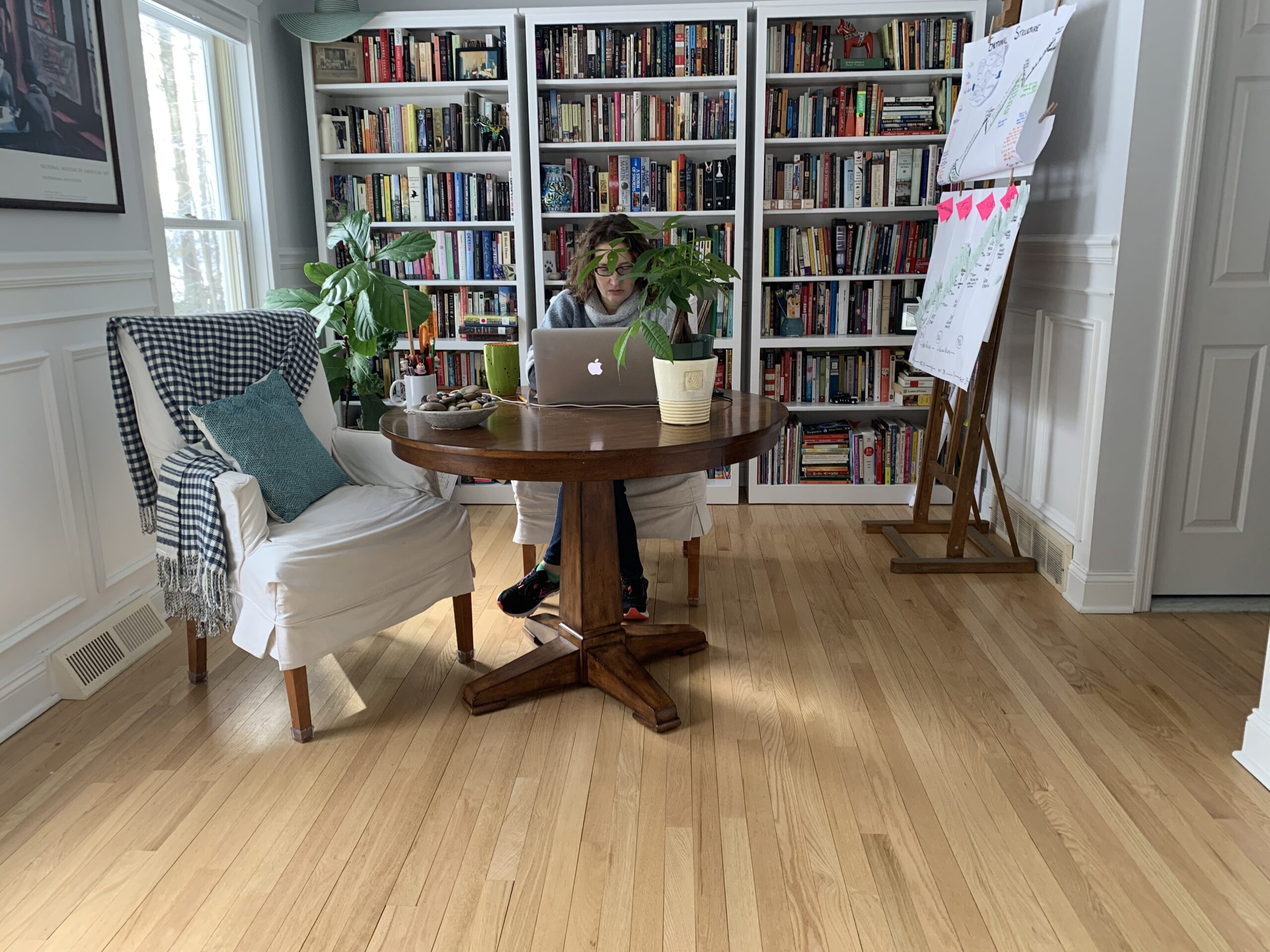

 What’s the best thing about transitioning from writer to debut author?
What’s the best thing about transitioning from writer to debut author?
EK: I’ve been thinking a lot about that old version of me—that 10-year-old girl—who wanted more than anything to be a published author. It’s a surreal and incredible thing to be able to give her this gift. How many people get to do that? It feels like a true privilege. And I think the gift feels all the bigger because of how long it took for me.
What’s the most challenging thing about transitioning from writer to debut author?
Every day I’m learning something new. Which in many ways is wonderful, because luckily I like to learn new things. But the learning curve is steep. It’s a bit daunting and tiring to be standing at the foot of yet another learning mountain on a near daily basis. Part of that is the debut year. But part of that is debuting in a pandemic. So even if I ask my mentors who are more experienced for advice or insight, none of them debuted in a pandemic so it makes things a bit more interesting for us pandemic debuters. Thankfully the kidlit community is the most inclusive and supportive of which I’ve ever been a part—so we’re weathering this together.
Please share any advice that’s helped you best (from others or yourself) in your kidlit career?
I think A LOT about my boat and I recommend every writer get themselves a boat. Inside my boat are the things I can control: honing my writing craft, how much I dedicate to my writing, how vulnerable I am on the page, getting the words on the page, teaching my kids to clap when I finish a draft. Literally everything else is outside my boat: book deals, reviews, lists, other people’s opinions, whether my kids actually clap, etc. It’s so helpful to train your focus inside your boat. In publishing, there are a lot of shiny somethings, lots of ego catnip, lots of opportunities to, as one writer friend likes to say, “compare and despair.” Retraining our focus to be inside our boat must be a habitual and intentional act. Let craft and our enjoyment of it be our unwavering center.
Hope Sparkers–what are they, and where can people get some?
I love that you asked! As you know, I’ve done a lot of research on hope and how helpful it can be for writers for children and young adults to incorporate hope as part of their writer’s toolkit. I made up the term “Hope Sparkler” to refer to all the things that I believe give us hope: friends/family/inspirational leaders in your community; religion/ philosophy/ belief system/ faith in ruling bodies; your own positive characteristics (creativity, humor, optimism, gratitude etc.); passion/talents (baking, gardening); place; and, of course, books. Books not only can contain hope sparklers but they can be them in their own right. If there’s anything we learned during this last year, it’s that we need as many hope sparklers as we can get. We need them to light our way during those dark days. And children need them most of all.
Where can writers and educators access your awesome Instagram videos for use in their practice or classroom?
Oh my gosh, these videos have been such a gift to me as well. Every single writer I’ve interviewed has offered such wisdom and inspiration. With the exception of one long-form video, all videos are about 15-minutes and packed with craft. At this point, there are thirty-six videos and you can find them all on my IGTV. I plan to offer these again during this year’s NaNoWriMo. I love any opportunity to blend my love of teaching and writing!
What’s on the horizon for Emma Kress?
I’m busy revising what I hope will be my second book—also a contemporary stand-alone YA. Like Dangerous Play, you can expect it to be feminist, funny, and fierce. On August 3rd, I’ll have a virtual launch with the great Nova Ren Suma along with several other upcoming launch events and writing workshops. I offer one general and one writing-focused newsletter every month (sign up here: https://www.emmakress.com/contact ). I’m also very active on all my social media. I look forward to connecting with all of you.
Some other mentions of Emma Kress and Dangerous Play to check out: A review on Publishers Weekly, a craft lesson on writing about sports on Kid Lit Craft.
Emma Kress is a long-time educator and 2014 finalist for NY State Teacher of the Year. She’s a graduate of Vassar College, Columbia University’s Teachers College, and the MFA program in Writing for Children and Young Adults at Vermont College of Fine Arts. She lives with her family in Saratoga Springs, NY. Dangerous Play is her debut novel. Learn more about Emma Kress and her amazing work on her website and on Instagram, Twitter, Facebook and TikTok.
by Elisa Zied | May 18, 2021 | books, fiction, VCFA, writer, writing, young adult books
Words Composed of Sea and Sky (Running Press Kids/Hachette, 5/25/21) by debut YA novelist Erica George had me at the gorgeous title, and stunning cover in hues of yellow and blue. But the novel itself more than lived up to my every expectation. George’s beautiful poetry and prose, the dual timelines, the evocative setting (Cape Cod), and the engaging and interwoven stories of two poets—Michaela Dunn and Leta Townsend—told in the current day and in the 1800s, respectively, make this a strong and worthwhile read. And if you’re a fan of layered characters and some swoon, this one’s for you.
I had the pleasure of doing a Q and A with George. Full disclosure: we first met when we shared a workshop at Vermont College of Fine Arts. I knew then of George’s talent and am thrilled for her debut and to share more about her novel and writing life.
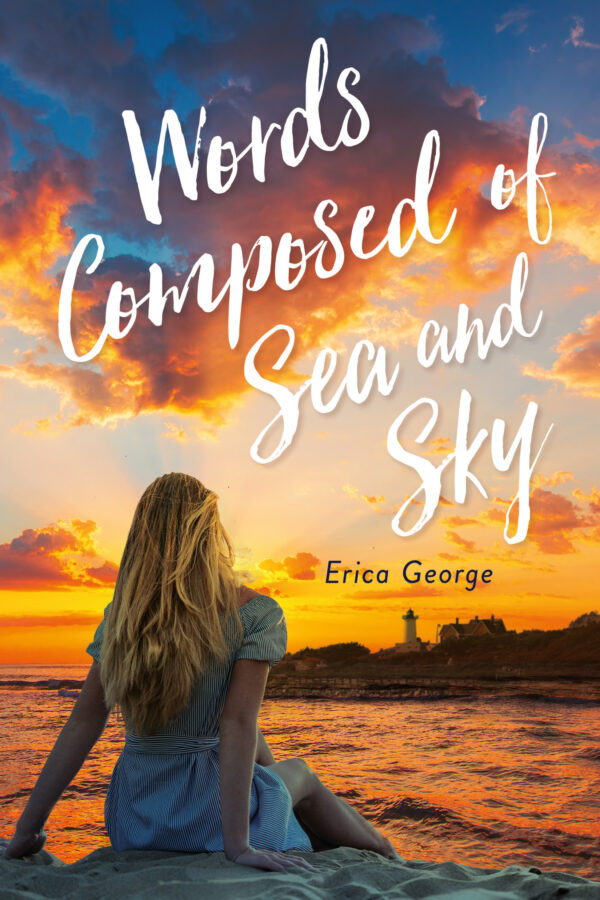 EZ: Was there a moment in time you discovered you were a writer, or was it something you’ve always done without thinking much about it?
EZ: Was there a moment in time you discovered you were a writer, or was it something you’ve always done without thinking much about it?
EG: Writing is something I’ve always done. There has never been a point in my life where I haven’t written (unless I wasn’t physically capable yet!), and there has never been a moment where I didn’t know that I was going to be an author.
EZ: What lured you to write fiction for children and young adults?
EG: I definitely think that being a teacher has made me gravitate toward writing for young people. I remember being a kid and trying to enjoy the books that were assigned to me in school, but also desperately wanting books that spoke to me (and were more interesting, let’s be honest!). Writing for young people is an honor I work hard to live up to.
EZ: How has your creative writing fit into your teaching life, and how has teaching/working with students informed your writing?
EG: They’re absolutely intertwined. I value student choice in reading and writing (as often as I can) in my classroom, so we’re always discussing what we’re reading or which author has a new book coming out. If I’m being honest, I would really have to think about the last adult book that I’ve read! There’s always a middle grade or young adult novel on my nightstand or in my bag.
EZ: You’re a candidate for an MFA at Vermont College of Fine Arts in the Writing for Children and Young Adults. What were your motivations for wanting to study at VCFA and how has the experience impacted your writing and career?
EG: Two of my critique partners actually have their MFAs from VCFA in Writing for Children and Young Adults, and they couldn’t say enough about the program. After doing my research, I knew that I wanted a degree that would not only benefit my writing career, but also instruct my teaching. There are so many topics we discuss at VCFA during workshops and seminars that I always jot down so that I remember to bring it up in a lesson or in conversation with my students.
EZ: What was the spark for, and trajectory of, your debut young adult novel, Words Composed of Sea and Sky?
EG: I think the initial spark began when I was thirteen (let’s not discuss how long ago that was!). I started writing about one of the characters in Words Composed of Sea and Sky, Captain Benjamin Churchill, when I was in middle school, and he hasn’t left me since then. He’s weaved his way in and out of books, trying to find which story belongs to him, and it didn’t all come together until the summer of 2018 when I decided I wanted to write a book about two female poets from two separate centuries, and suddenly he just belonged. He had an effect on both of my main characters (for better or for worse!)
EZ: What have been the best parts of being a debut author so far (being a 21der etc.), and what’s next for you?
EG: Being a part of the debut process with my fellow 21ders has been a dream. I’m so lucky to be a part of a group with so many talented, driven, and supportive authors. Currently, I’m in the middle of revisions for my second novel, a YA contemporary called The Edge of Summer, coming out with Little, Brown BFYR in summer of 2022. It’s about a girl named Coriander who spends her summer on Cape Cod completing a marine biology internship all while she copes with the unexpected loss of her best friend, first love, and rescuing a humpback whale from entanglement.
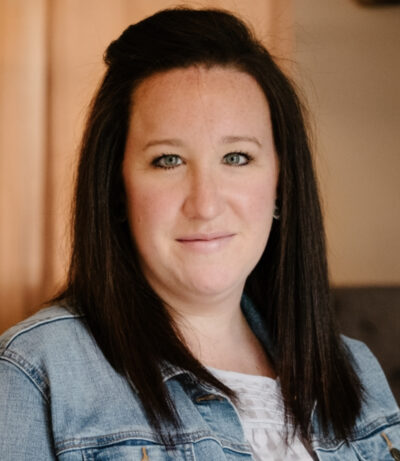 EZ: If you had to give advice to writers about craft, and the profession, what would it be? (Or what was the best advice for either you’ve received?)
EZ: If you had to give advice to writers about craft, and the profession, what would it be? (Or what was the best advice for either you’ve received?)
EG: I think that the best advice that I’ve received and that I would pass on (and it works every time), is to make sure you always have something you could be working on. There is so much waiting in the publishing industry! So much. It’s a constant game of “hurry up and wait,” and sometimes the waiting can be absolutely painful. What makes it go by more quickly is working on something new—focusing your energy on something that’s within your control.
EZ: Who are some of your favorite authors? Any favorite recent reads/books on your nightstand that you’re excited to get to?
EG: Such a good question! I love Leigh Bardugo, Elizabeth Acevedo, Jennieke Cohen, Jeff Zentner, Laura Taylor Namey, Jason Reynolds, Gita Trelease, Joy McCullough, (and let’s not forget Jane Austen!). The list goes on and on. This is not at all exhaustive! Currently on my nightstand, I’m reading Don’t Call the Wolf by Aleksandra Ross.
EZ: Where do you do most of your writing/what are the conditions that are most ideal for you? And if you could write anywhere, where would you go—and what would that day look like?
EG: My typical writing conditions are in my office with soft music playing, a lit candle, and my dog snoozing next to me. These are not my ideal writing conditions, though! Inevitably when I write from home, I find something to distract me from getting my words down. I really enjoy writing in libraries or coffee shops, or even writing at a friend’s house. Anywhere really, as long as the only thing I have to focus on is writing.
EZ: What’s next for you, and how can readers/educators learn more about your work?
EG: Words Composed of Sea and Sky hits shelves with Running Press Kids/Hachette on 5/25/21, and you can preorder using this link.
You can find more information about Erica, my books, and upcoming events on my website, www.ericageorgewrites.com
Erica George is a writer of young adult fiction. She is a graduate of The College of New Jersey with degrees in both English and education, and is currently an MFA student at Vermont College of Fine Arts. She resides in scenic northern New Jersey, but spends her summers soaking up the salty sea air on Cape Cod.
 The moment I read about Coming of Age: 13 B’Nai Mitzvah Stories (Albert Whitman & Co., April 19, 2022), an anthology edited by Jonathan Rosen and Henry Herz, I knew it would be a must-read—and not just for its intended audience of 8 to 12-year-olds. Maybe the idea of the book made me nostalgic for my own bat mitzvah celebration that featured sparkly rainbow/unicorn centerpieces. Maybe it reminded me of the feeling of accomplishment after performing on the bimah after several months of practice alongside my friend Melissa. Maybe it was about remembering the party following my service, especially the rush of a slow dance with a cute boy to some early 80s ballad, or the fun of playing games like Coke and Pepsi and musical chairs with my school, camp, and family friends.
The moment I read about Coming of Age: 13 B’Nai Mitzvah Stories (Albert Whitman & Co., April 19, 2022), an anthology edited by Jonathan Rosen and Henry Herz, I knew it would be a must-read—and not just for its intended audience of 8 to 12-year-olds. Maybe the idea of the book made me nostalgic for my own bat mitzvah celebration that featured sparkly rainbow/unicorn centerpieces. Maybe it reminded me of the feeling of accomplishment after performing on the bimah after several months of practice alongside my friend Melissa. Maybe it was about remembering the party following my service, especially the rush of a slow dance with a cute boy to some early 80s ballad, or the fun of playing games like Coke and Pepsi and musical chairs with my school, camp, and family friends.
 I actually did not have a traditional bat mitzvah. My synagogue called it a “Bat Torah,” although we girls were not brought up to the bimah on Saturday to read from the actual Torah. Instead, we read a selection from the Book of Proverbs during the Friday night service. I was only the third girl in our congregation to have the ceremony. The “Bat Torah” was a compromise with our old-school rabbi, who did not feel women had any place on the bimah at all. It was a hard-fought battle, led by many girls in the Hebrew school, and our equally fierce parents. Today, young women in that same congregation have full-fledged b’not mitzvah, and the cantor is a woman. So, I guess what I learned is that change is hard, and it may take a lot of time, but it does come. Never give up fighting for equality in all aspects of life.
I actually did not have a traditional bat mitzvah. My synagogue called it a “Bat Torah,” although we girls were not brought up to the bimah on Saturday to read from the actual Torah. Instead, we read a selection from the Book of Proverbs during the Friday night service. I was only the third girl in our congregation to have the ceremony. The “Bat Torah” was a compromise with our old-school rabbi, who did not feel women had any place on the bimah at all. It was a hard-fought battle, led by many girls in the Hebrew school, and our equally fierce parents. Today, young women in that same congregation have full-fledged b’not mitzvah, and the cantor is a woman. So, I guess what I learned is that change is hard, and it may take a lot of time, but it does come. Never give up fighting for equality in all aspects of life. There was a lot of family drama around my bat mitzvah. I wanted to write a story that captured that anxious feeling, but put a funny spin on it. To write “A Funny Thing Happened on the Way to the Bimah,” I studied farce, including the Stephen Sondheim musical, “A Funny Thing Happened on the Way to the Forum.”
There was a lot of family drama around my bat mitzvah. I wanted to write a story that captured that anxious feeling, but put a funny spin on it. To write “A Funny Thing Happened on the Way to the Bimah,” I studied farce, including the Stephen Sondheim musical, “A Funny Thing Happened on the Way to the Forum.”  I’ve been wanting to do a Jewish-oriented story for a long time, so when I was invited to contribute to the anthology Coming of Age, it was an immediate yes. It was important for me to write something authentic, which is why I often write close to my own experiences. But my bat mitzvah was a by the book affair; there was nothing to draw on. So, I turned to history. I was fascinated to learn the first bat mitzvah in the country was in 1922 by Judith Kaplan, the daughter of a prominent New York City rabbi. That awakened my feminist leanings—why did it take so long, what kind of event was it? So, I investigated.
I’ve been wanting to do a Jewish-oriented story for a long time, so when I was invited to contribute to the anthology Coming of Age, it was an immediate yes. It was important for me to write something authentic, which is why I often write close to my own experiences. But my bat mitzvah was a by the book affair; there was nothing to draw on. So, I turned to history. I was fascinated to learn the first bat mitzvah in the country was in 1922 by Judith Kaplan, the daughter of a prominent New York City rabbi. That awakened my feminist leanings—why did it take so long, what kind of event was it? So, I investigated.
 Poetry was a wonderful choice for Haydu’s poignant, heart-wrenching, and ultimately hopeful novel. It is raw, sometimes painful, and relatable to anyone who has ever felt trapped in their lives (such as during a pandemic), or trapped in/defined by their bodies, or powerless to speak out and make necessary change. Haydu explores mother/daughter relationships and all they entail (body image, power dynamics) across generations with courage and care, something that resonates with readers and reviewers alike.
Poetry was a wonderful choice for Haydu’s poignant, heart-wrenching, and ultimately hopeful novel. It is raw, sometimes painful, and relatable to anyone who has ever felt trapped in their lives (such as during a pandemic), or trapped in/defined by their bodies, or powerless to speak out and make necessary change. Haydu explores mother/daughter relationships and all they entail (body image, power dynamics) across generations with courage and care, something that resonates with readers and reviewers alike. You now have various works published across so many genres (chapter books, middle grade and young adult novels (prose and verse). From creative and business standpoints, what have been the upsides of writing in so many different genres? Any challenges?
You now have various works published across so many genres (chapter books, middle grade and young adult novels (prose and verse). From creative and business standpoints, what have been the upsides of writing in so many different genres? Any challenges? How has the pandemic impacted your writing life in terms of finding time and being in the headspace to do your best work? You’re obviously prolific and productive despite it all, so what has been most helpful to you in terms of getting it done?
How has the pandemic impacted your writing life in terms of finding time and being in the headspace to do your best work? You’re obviously prolific and productive despite it all, so what has been most helpful to you in terms of getting it done? In what ways has your writing process and daily practice changed since writing your debut novel, The Library of Lost Things?
In what ways has your writing process and daily practice changed since writing your debut novel, The Library of Lost Things? You dive deep into the ocean (pun intended), medicine, opera, becoming a Navy SEAL, and so much more in your novel. What did you know about each of these ahead of time, and what kind of research did you have to do before/while writing WWWT?
You dive deep into the ocean (pun intended), medicine, opera, becoming a Navy SEAL, and so much more in your novel. What did you know about each of these ahead of time, and what kind of research did you have to do before/while writing WWWT?  What was the best part about having your sophomore novel, A Cuban Girl’s Guide to Tea and Tomorrow, become
What was the best part about having your sophomore novel, A Cuban Girl’s Guide to Tea and Tomorrow, become 
 No one knew just how bad Joey Ward’s addiction was until the night Candy MontClaire died. Four months later, he’s back from rehab, hoping for a fresh start in a town that doesn’t know how to forgive. His sister, Emory, is tasked as his keeper. Because in a family with a “beautiful one” (her glamorous and outgoing older sister Maddie) and a “bad one” (Joey), Emmy has always been “the good one.” Of course she’ll keep her brother safe. She loves Joey more than anything. She’ll do anything to keep him alive.
No one knew just how bad Joey Ward’s addiction was until the night Candy MontClaire died. Four months later, he’s back from rehab, hoping for a fresh start in a town that doesn’t know how to forgive. His sister, Emory, is tasked as his keeper. Because in a family with a “beautiful one” (her glamorous and outgoing older sister Maddie) and a “bad one” (Joey), Emmy has always been “the good one.” Of course she’ll keep her brother safe. She loves Joey more than anything. She’ll do anything to keep him alive. What has been the most rewarding part of being a young adult novelist? What has been the most challenging part?
What has been the most rewarding part of being a young adult novelist? What has been the most challenging part? Described by
Described by 
 What was the spark that led to Dangerous Play, why was it important for you to write this particular story, and what did the process from spark to book look like?
What was the spark that led to Dangerous Play, why was it important for you to write this particular story, and what did the process from spark to book look like?

 What’s the best thing about transitioning from writer to debut author?
What’s the best thing about transitioning from writer to debut author? EZ: Was there a moment in time you discovered you were a writer, or was it something you’ve always done without thinking much about it?
EZ: Was there a moment in time you discovered you were a writer, or was it something you’ve always done without thinking much about it? EZ: If you had to give advice to writers about craft, and the profession, what would it be? (Or what was the best advice for either you’ve received?)
EZ: If you had to give advice to writers about craft, and the profession, what would it be? (Or what was the best advice for either you’ve received?)
Recent Comments